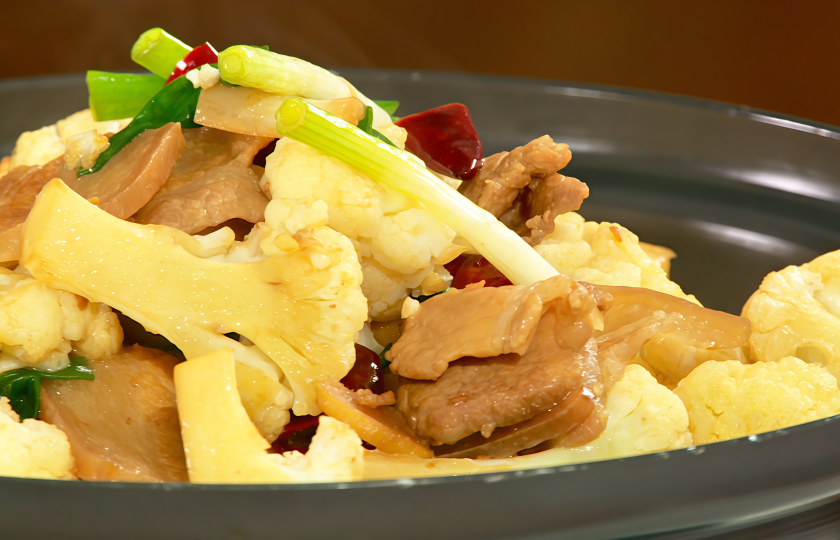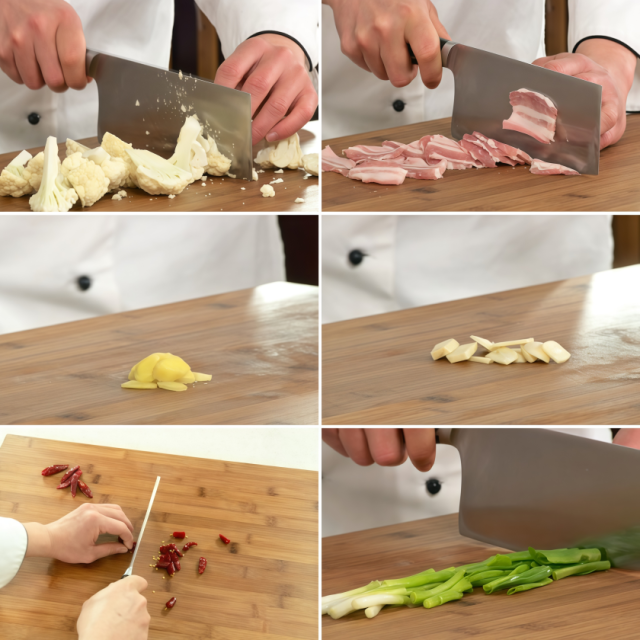Chinese Dry Pot Cauliflower


A perfect Dry Pot Cauliflower maintains the vegetable's crisp tenderness while absorbing rich flavors. Let's uncover the secrets of this memorable dry pot dish.
Why is it called "Dry Pot" Cauliflower?
There is a reason why this dish is called Dry Pot Cauliflower. Restaurants usually cook this kind of dish in a small wok over low heat.
"Dry Pot" means stir-frying the ingredients at a relatively high temperature instead of stewing with too much water, so that the ingredients have a bit of charred aroma while maintaining a crispy texture.
The key to this dish lies in the integration of the fat of the pork belly and the seasonings, allowing the cauliflower to fully absorb the flavors, rather than producing a lot of soup.
Dry pot dishes have two characteristics
Spicy: The spiciness comes from dried chili peppers, fresh chili peppers and/or pre-made chili sauces (such as Sichuan bean paste).
Dry: It looks relatively dry, that is, there is very little soup or sauce. But the taste of dry pot dishes is usually quite strong.

What kind of cauliflower is suitable for this dish?
I use Chinese organic cauliflower to make this dish. This kind of cauliflower has a long stem and a crisper texture after being cooked.
You can usually find them in Chinese/Asian grocery stores. Of course, you can use regular cauliflower or organic cauliflower as a substitute.
What kind of pot should be used?
When making Dry Pot Cauliflower, it is best to choose a non-stick pan or a cast-iron pan. These two types of pans can be heated evenly, ensuring that the ingredients are not easily stuck to the pan. Moreover, the cast-iron pan has good airtightness, which can keep the aroma of the dish.
If you have an iron pan or a wok at home, that's also fine. The key is that the pan should be hot and the stir-frying should be fast, so that the cauliflower can maintain a crispy and tender texture.
INGREDIENTS
Main Ingredients
-
·500g cauliflower (cut into small florets)
-
·150g pork belly (sliced into thin pieces)
Additional Ingredients
-
·10g ginger (sliced)
-
·10g garlic (sliced)
-
·10g dried chili peppers (cut into small sections)
-
·20g green onions (cut into segments)
Seasonings
-
·10g salt (for seasoning when blanching)
-
·8g salt (for seasoning when stir - frying)
-
·15ml cooking oil
-
·5ml dark soy sauce
-
·10ml steamed fish soy sauce
Table of Contents
- ·Why is it called "Dry Pot" Cauliflower?
- ·Dry pot dishes have two characteristics
- ·What kind of cauliflower is suitable for this dish?
- ·What kind of pot should be used?
- ·Ingredients
- ·Cooking step
- ·More recipes worth trying
- ·Professional Tips
- ·What dishes can be paired with Dry Pot Cauliflower?
- ·Storage Tips
- ·FAQs
COOKING STEP
Step 1
Wash the 500g cauliflower and cut it into small florets, then set aside. Slice the 150g pork belly into thin pieces. Cut 10g ginger into slices, 10g garlic into slices, 10g dried chili peppers into small sections and 20g green onions into segments.

Step 2
After half a pot of hot water boils, add 10g salt. Pour the cut cauliflower into the boiling water and blanch for 1 - 2 minutes. When the cauliflower is slightly soft but still crispy and tender, remove it with a ladle and drain the water, setting it aside.

Step 3
Dry the pan and pour in 15ml cooking oil. When the oil is hot, add the pork belly slices and stir - fry over medium - low heat until both sides of the pork belly turn slightly golden and the fat gradually comes out.

Step 4
Add the ginger slices and garlic slices, and quickly stir - fry over high heat until the fragrance spreads. Then add the dried chili pepper sections and continue to stir - fry until fragrant.

Step 5
Pour in 5ml dark soy sauce to color, then add 10ml steamed fish soy sauce to enhance the freshness. Stir well to make the pork belly fully absorb the seasonings.

Step 6
Pour the previously blanched cauliflower into the pan, then add 8g salt to season. Use a spatula to quickly stir - fry to evenly blend and flavor the cauliflower and pork belly.

Step 7
Finally, add the green onion segments. Stir a few times until the fragrance of the green onions spreads, then immediately turn off the heat. Serve the dish on a plate.

More recipes worth trying
Sour & Spicy Baby Chinese Cabbage Recipe
Ma La Xiang Guo (Sichuan Mala Dry Pot) Recipe
Professional Tips
Blanching Skills
Adding salt during blanching can make the cauliflower crisper and more tender, and also help maintain its bright color. The blanching time should be controlled within 1 - 2 minutes. If the time is too long, the cauliflower is likely to lose its crispness.
Stir - frying the Pork Belly
When stir - frying the pork belly, the heat should be moderate. Using medium - low heat can slowly extract the fat from the pork belly, making the slices crispy. If the heat is too high, the pork belly is prone to burning.
Seasoning Proportion
The proportion of dark soy sauce and steamed fish soy sauce is very important. Dark soy sauce is mainly used for coloring, while steamed fish soy sauce adds freshness. Remember not to add too much of these seasonings to avoid making the dish too salty.
Stir - frying the Cauliflower
When stir - frying the cauliflower, use high heat and quick stir - frying to maintain its crispy and tender texture. If the pan is too small or the stir - frying time is too long, the cauliflower is likely to become mushy.
Adding Green Onions for Garnish
It is best to add the green onion segments at the end. This way, the fragrance of the green onions can be retained in the dish without being overcooked, resulting in a better taste.
What dishes can be paired with Dry Pot Cauliflower?
This Dry Pot Cauliflower can be paired with some fresh or tender dishes to create a more balanced taste. Here are some recommended pairings:
Stir - fried Seasonal Vegetables: Dishes like stir - fried water spinach or stir - fried spinach are simple and fresh. They can remove the greasiness of the cauliflower, making the meal light and healthy.
Spicy Tofu: If you prefer a stronger flavor, you can try spicy tofu. The tofu absorbs the sauce fully, being smooth, tender and chewy. It definitely makes a great match with cauliflower!
Garlic Broccoli: Broccoli has a fresh texture and a strong garlic flavor. It is very suitable to be paired with this cauliflower dish, and the colors also complement each other perfectly.
Pan - fried Eggplant: The soft eggplant with a hint of garlic flavor. Taking a bite, the contrast in texture between the cauliflower and eggplant is quite interesting.
Stewed Soup: Clear stewed pork rib soup or chicken soup. The soup is light and non - greasy, perfectly balancing the taste of Dry Pot Cauliflower and making the whole meal more cozy.
Storage Tips
Refrigeration: Since Dry Pot Cauliflower contains pork, it is best to refrigerate the leftovers and consume them within four days.
Freezing: Dry Pot Cauliflower is not suitable for freezing because the cauliflower will become a bit soggy and the taste will not be as fresh. If you really need to freeze the leftovers, we recommend consuming them within a month.
FAQs:
If the florets are too large, you can tear them into smaller pieces by hand. For the thicker part of the root, you can gently peel off the outer skin with a knife, which makes it easier for the cauliflower to absorb flavors.
Restaurants do this to enhance the flavor, but for home cooking, it is really not necessary.
In contrast, the florets of Chinese cauliflower are looser, with a more yellowish color. It has a smoother, more tender texture and a slightly sweet taste.
Chinese cauliflower is generally more suitable for quick stir - frying, and its flavor is relatively mild.
In terms of seasoning, you can use vegan oyster sauce or light soy sauce to replace the steamed fish soy sauce to enhance the freshness.

















